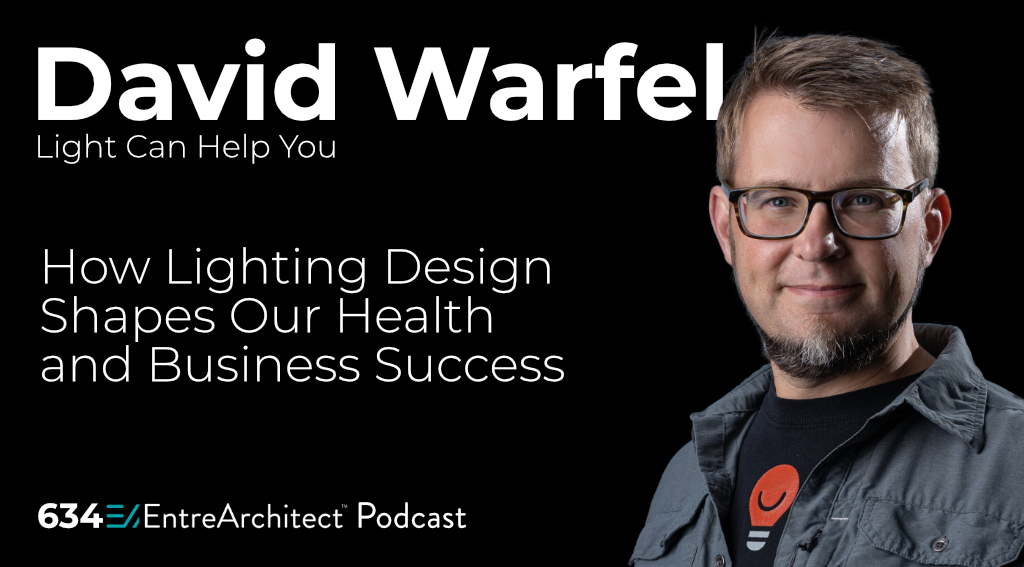
Why Architects Must Rethink Light as a Daily Human Need, Not Just a Design Feature
If there is one lesson I hope every architect takes from my conversation with David Warfel, it is this: light is not just a technical layer of our projects. Light is a fundamental force shaping how people feel, think, work, sleep, and heal.
And until we understand that truth, we will continue to design environments that fall short of what humans actually need.
When I talk with David, I’m always struck by how much of our daily experience is controlled by light and how little attention we’ve given it in architectural practice. His clarity, enthusiasm, and deep knowledge of the science always leave me thinking differently about the spaces we create.
This episode reminded me that light can help you in more ways than we typically imagine. It can help you become a better architect. It can help you design healthier buildings. And it can help you live a better life yourself.
Light Is Not Just About Seeing
Most of us were taught that lighting design is about visibility. Provide enough foot-candles. Avoid glare. Make sure people can read, move, and work. That was the old way.
Today, we know better.
Light is a biological input that triggers chemical responses throughout the body. When photons enter the eye, they travel not only to the visual system but also to centers of the brain that regulate mood, alertness, sleep cycles, hormone production, and long-term health.
We are finally learning what light has been doing to us all along.
And as David explained, we now have decades of research confirming that light on the brain acts the same way caffeine does. A few minutes of morning sunlight can raise alertness as effectively as a cup of coffee.
This is not theoretical. This is neuroscience. It’s happening every day whether we pay attention to it or not.
Architects Shape Human Biology More Than We Realize
If light governs these basic biological functions, then architects carry a responsibility we don’t always acknowledge. We decide where light enters a building, how it’s distributed, how it’s controlled, and what its character will be throughout the day.
That means we are directly influencing:
- How people sleep
- How alert they feel
- How productive they can be
- How emotionally stable they are
- How their bodies regulate essential hormones
- How their long-term health may develop
Take that in for a moment. We are not just creating space. We are shaping biology.
When we reduce light to a grid of recessed cans or a safe, uniform foot-candle level, we miss the deeper opportunity. We miss the chance to serve people more fully. And we miss the chance to make our designs perform the way they were meant to.
Why Morning Light Matters Most
One of the most important takeaways from David is that the timing of light is as important as the amount. Our bodies evolved outdoors, surrounded by dynamic light that changed throughout the day.
In modern interiors, we’ve replaced that natural rhythm with static light that is almost always wrong for the moment we are in.
In the morning, the body expects bright, cool, energizing light. It uses this early burst to regulate our internal clock, prepare the brain for focus, and set the foundation for healthy sleep much later that night.
Most people spend those morning hours indoors under dim, indirect light. And many of us drive to work wearing sunglasses, which block even more of what the body needs.
If you take only one practical idea from this episode, make it this: get outside in the morning and let your eyes absorb real daylight. Even ten minutes will change how you feel throughout the day.
Why Evening Light Matters Just as Much
In the evening, the equation flips. The body expects warm, soft, low light coming from eye level or below, much like firelight.
Overhead brightness at night disrupts circadian rhythms. It sends signals that we should stay alert even when the body needs to wind down. And that disruption affects mood, performance, and health the next day.
The buildings we design rarely follow this natural pattern. We switch on bright ceiling lights long after sunset, asking the body to function inside a rhythm it was never meant to experience.
David reminded us that this mismatch creates a form of “social jet lag,” pushing the body out of sync with the day and leaving us tired, unfocused, and unrested.
Architects can change that. We can design for light that follows the arc of the day instead of fighting against it.
Why Architects Must Stop Thinking in Terms of Fixtures
One of my favorite lines from David is this idea that natural light doesn’t come from a single point. We’re not meant to live with isolated bright spots. When we walk outdoors, light surrounds us. It bounces off the ground, the sky, the clouds, and the landscape.
Light arrives evenly, softly, and from all directions.
Inside, most buildings do the opposite. They drop light out of the ceiling in concentrated points, often uncontrolled and often uncomfortable.
David argues for a simple shift: stop thinking about where the fixture goes and start thinking about where the light goes. That means:
- Washing walls with light
- Using indirect sources
- Concealing bright points
- Bringing light closer to the horizon line
- Designing gradients rather than grids
This approach doesn’t just look better. It feels better. It’s more aligned with the way the human eye and brain process light. And it supports healthier patterns of living.
Light Can Help You Do Better Work
Architects tend to design based on what we know. Most of us were taught that lighting is a technical layer, not a human one. Yet every day, we learn more about how light affects everything from learning outcomes to emotional stability.
Light can help you create better buildings.
Light can help you help your clients thrive.
Light can help you build a practice that truly improves the lives of the people you serve.
This is part science, part design, and part responsibility.
Light Can Help You Live a Better Life
David’s advice hasn’t only changed the way I practice architecture. It has changed the way I live my own life.
Over the past few years, I’ve made a point of eating breakfast outside whenever the weather allows. Same for lunch. I walk the dogs in the sun. I take breaks to sit outdoors. I take advantage of natural light as much as possible.
I spend long hours in my office. Many of you do too. And I know what chronic indoor life feels like. The more I step outside and reconnect with the sun, the better I sleep, the calmer I feel, and the more clarity I have in my day.
We can’t change the fact that many of us work indoors. But we can change how we live around it.
If you’re an architect, you can change how your clients live around it too.
The Future of Light Is Human
One of the most hopeful parts of talking with David is hearing how the field is evolving. We now have the technology to mimic natural light more accurately, tune color temperature throughout the day, reduce environmental impact with low-voltage systems, and create controls that align lighting with human needs.
The next decade will bring even more opportunities to integrate biology into design. And architects who understand those tools will lead the way.
The truth is simple: light can help you, if you let it.
It can help you see your work differently.
It can help your clients live healthier lives.
It can help you push the profession forward.
This episode with David Warfel is worth your time. Listen to it, absorb it, and let it influence the way you think about the spaces you create.
Listen to the full conversation at https://entrearchitect.com/634.
Light can help you. And as architects, it’s time we take that seriously.

Leave a Reply